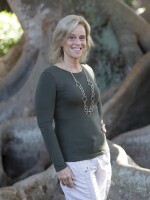A towering oak tree draped with Spanish moss offers little relief from the Florida sun as Andrew Lumish scrubs grime from the headstone of a World War I veteran.
"It's pretty messy, pretty dirty," he says. "We're pulling out dirt and biological material that's been here since 1921. So, a lot of elbow grease here."
Lumish, who has so far cleaned about 600 veterans' headstones, says he restores them out of respect for those who died and to learn about how they lived.
This is an opportunity to restore some of the dignity and honor that they have earned.
Among the stories he's unearthed: a veteran born in 1840 who was shot and returned to combat with a bullet in his lower back, a Civil War veteran wounded at the Battle of Shiloh and a 21-year-old whose headstone reads, "You have died for the world, but not for your parents."
Woodlawn Cemetery dates back to 1888, and is just blocks from Tampa's downtown skyscrapers. The burial ground houses the remains of soldiers who fought in conflicts from the Civil War to Vietnam. Many of the graves have been darkened by mold and mildew and some of the names inscribed in stone are unreadable.
"If you were just walking or driving by, you would just see a weathered, very dirty monument and would have no idea who it belonged to," Lumish says.
He started restoring headstones of military veterans five years ago. It all began when the history buff was taking photos at another cemetery and saw dozens of headstones in terrible shape.
Lumish isn't a veteran, but he does own a cleaning company and knew there was something he could do about it.

"At first it was to respect those who served to preserve our rights to everything that we do today and all of our freedoms," he says of the project. "On a personal level, I have friends who served who didn't necessarily make it through. Some who died, and some who suffer from the aftereffects of war."
Each Sunday, Lumish packs his car with 25 gallons of water, an assortment of brushes and an environmentally safe cleaning solution. That last part, he says, is the most important.
"Because when people see the results of what I do, everyone wants to get a big brush, some bleach and a power washer," he says. "In the hope of doing something good, people can actually do permanent damage."
Lumish says his cleaning process can take anywhere from four days to four months to complete.
Since sandstone and limestone are porous, it can take some time for caked-in biological matter to break down. Gravestones made of marble and granite are easier to clean because the dirt is mostly on the surface.
But what Lumish uncovers is much more than names and dates etched in stone.
'I think about what they fought for'
As the 46-year-old walks through the cemetery, he can point to markers he's already cleaned and he can tell you how each veteran died.
They were not considered heroes of their day, so I hope that some of the stories that I tell make people appreciate the men and women that serve currently.
"I put myself in the shoes of the people who are here," he says. "I think of the times in which they lived. I think of their families and I think about what they fought for."
But Lumish also actually learns how these men and women lived.
On his " Good Cemeterian" Facebook page, he posts photos and stories of the deceased. He gets the information from genealogy websites and finds new articles, draft notices and death certificates at the library.
"We uncover heroes," he says. "They were not considered heroes of their day, so I hope that some of the stories that I tell make people appreciate the men and women that serve currently. There are heroes today that surround us on a daily basis."
Lumish's Facebook research page has received thousands of hits, including one from Paul Heimel, a county commissioner from the central mountain region of Pennsylvania.
"I just thought to myself, if a guy in Florida can do this and we have a commitment to do it, let's give it a shot," Heimel says.
This month, Pennsylvania's Potter County, with consulting help from Lumish, began a project to clean the tombstones of veterans buried in the cemeteries there.
"To have a veteran's stone fall apart and then have his name covered by moss and lichens just isn't right," Heimel says. "But the part that we really need to restore and permanently save is the record of who that person was. This is an opportunity to restore some of the dignity and honor that they have earned."
Back at the Tampa cemetery, Lumish kneels in the grass and uses a toothbrush to scrub dirt from the nooks and crannies of a large ornate tomb.
"In the next month, this monument is going to be spectacular," he says. "It's a sad occasion, but there's nothing I can do to change what has happened to some of the people who we lost so long ago."
But what he can do, he says, is keep their memories alive.
Cathy Carter
reports on education for member station WUSF.
9(MDAyNDY5ODMwMDEyMjg3NjMzMTE1ZjE2MA001))
Copyright 2017 WUSF Public Media - WUSF 89.7




